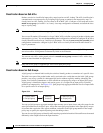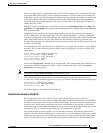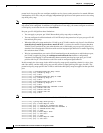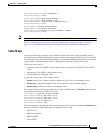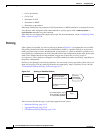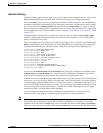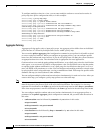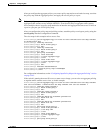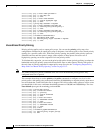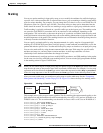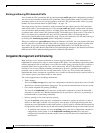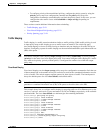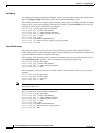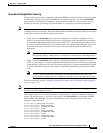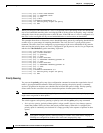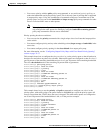
33-18
Cisco ME 3400 Ethernet Access Switch Software Configuration Guide
OL-9639-06
Chapter 33 Configuring QoS
Understanding QoS
Switch(config-pmap)# class video-provider-2
Switch(config-pmap-c)# set dscp cs4
Switch(config-pmap-c)# exit
Switch(config-pmap)# class class-default
Switch(config-pmap-c)# police aggregate agg1
Switch(config-pmap-c)# exit
Switch(config)# policy-map customer-1-ingress
Switch(config-pmap)# class customer1-provider-100
Switch(config-pmap-c)# service-policy child-policy-1
Switch(config-pmap-c)# exit
Switch(config-pmap)# class customer1-provider-200
Switch(config-pmap-c)# service-policy child-policy-2
Switch(config-pmap-c)# exit
Switch(config)# interface fastethernet0/1
Switch(config-if)# switchport mode trunk
Switch(config-if)# service-policy input customer-1-ingress
Switch(config-pmap-c)# exit
Unconditional Priority Policing
Priority policing applies only to output policy maps. You can use the priority policy-map class
configuration command in an output policy map to designate a low-latency path, or class-based priority
queuing, for a specific traffic class. With strict priority queuing, the packets in the priority queue are
scheduled and sent until the queue is empty, at the expense of other queues. Excessive use of
high-priority queuing can create congestion for lower priority traffic.
To eliminate this congestion, you can use the priority with police feature (priority policing) to reduce the
bandwidth used by the priority queue and allocate traffic rates on other queues. Priority with police is
the only form of policing supported in output policy maps. See also the
“Configuring Output Policy
Maps with Class-Based Priority Queuing” section on page 33-57.
Note You cannot configure a policer committed burst size for an unconditional priority policer. Any
configured burst size is ignored.
This example shows how to use the priority with police commands to configure out-class1 as the
priority queue, with traffic going to the queue limited to 20,000,000 bps so that the priority queue never
uses more than that. Traffic above that rate is dropped. This allows other traffic queues to receive some
port bandwidth, in this case a minimum bandwidth guarantee of 500,000 and 200,000 kbps. The class
class-default queue gets the remaining port bandwidth.
Switch(config)# policy-map policy1
Switch(config-pmap)# class out-class1
Switch(config-pmap-c)# priority
Switch(config-pmap-c)# police 200000000
Switch(config-pmap-c)# exit
Switch(config-pmap)# class out-class2
Switch(config-pmap-c)# bandwidth 500000
Switch(config-pmap-c)# exit
Switch(config-pmap)# class out-class3
Switch(config-pmap-c)# bandwidth 200000
Switch(config-pmap-c)# exit
Switch(config-pmap)# exit
Switch(config)# interface gigabitethernet0/1
Switch(config-if)# service-policy output policy1
Switch(config-if)# exit



